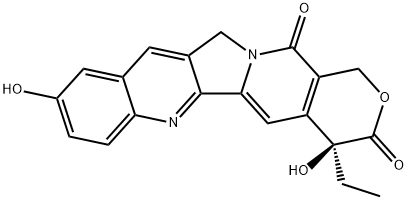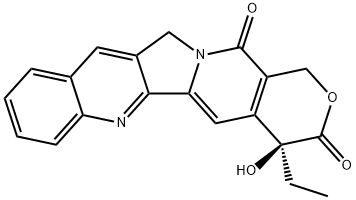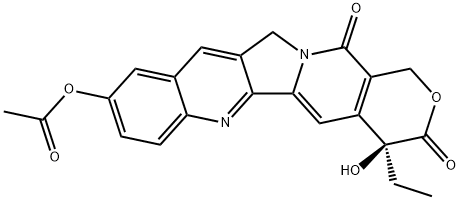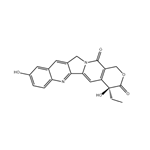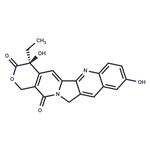Description
DNA topoisomerases relax supercoiled DNA during replication, transcription, recombination, repair, and chromosome condensation. The relaxation of DNA supercoiling by topoisomerase I at single-
strand breaks represents a target for anticancer agents to intercalate between DNA base pairs, leading to the activation of apoptotic and cell cycle arrest pathways. (S)-
10-
hydroxy-
Camptothecin is an inhibitor of topoisomerase I originally isolated from the Chinese tree
C. acuminata. It is a member of the camptothecin family that demonstrates less toxicity than its parent compound. (S)-
10-
hydroxy-
Camptothecin has strong anti-
tumor activity against a wide range of experimental tumors including L1210 leukemia cells (IC
50 = 1.15 μM). In vitro treatment of human HepG2 cells with 5-
20 μM (S)-
10-
hydroxy-
camptothecin results in cell cycle arrest at the G
2/M phase.
Chemical Properties
Yellow Solid
Uses
A Camptothecin derivative; a topoisomerase inhibitor for cancer therapy
Definition
ChEBI: 10-Hydroxycamptothecin is a pyranoindolizinoquinoline.
in vitro
10-Hydroxycamptothecin inhibited the growth of BT-20 and MDA-231 cells with IC50 of 34.3nM and 7.27nM, respectively, which was more potent than camptothecin (CPT) with IC50>500nM. 10-Hydroxycamptothecin potently induces the formation of the pBR322 plasmid DNA cleavage complex mediated by human topoisomerase I with an EC50 of 0.35 μM, more than 50-fold more potent than CPT with an EC50 of 18.85 μM. 10-Hydroxycamptothecin treatment caused dose-dependent growth inhibition of human microvascular endothelial cells (HMECs) with IC50 of 0.31 μM and significantly inhibited HMEC migration with IC50 of 0.63 μM. Treatment of HMEC cells with 10-Hydroxycamptothecin also inhibited microtubule formation in a dose-dependent manner with IC50 of 0.96 μM. 10-Hydroxycamptothecin (5-20 nM) significantly inhibits the differentiation of Colo205 cells, arrests the cell cycle in G2 phase, and induces apoptosis through a caspase-3-dependent pathway.
in vivo
In the CAM model, 10-Hydroxycamptothecin treatment inhibited angiogenesis in a concentration-dependent manner, with 95% inhibition at 25 nM, more potent than suramin, which inhibited only 60% of angiogenesis at 125 nM. 10-Hydroxycamptothecin, administered orally at low doses of 2.5-7.5 mg/kg every two days, caused significant growth inhibition in Colo205 xenograft mice, but no acute toxicity. LD50: 104 mg/kg in mice (intraperitoneal injection).
References
[1] vladu b, woynarowski jm, manikumar g, wani mc, wall me, von hoff dd, wadkins rm. 7- and 10-substituted camptothecins: dependence of topoisomerase i-dna cleavable complex formation and stability on the 7- and 10-substituents. mol pharmacol. 2000 feb;57(2):243-51.
[2] xiao d, tan w, li m, ding j. antiangiogenic potential of 10-hydroxycamptothecin. life sci. 2001 aug 24;69(14):1619-28.
[3] ping yh, lee hc, lee jy, wu ph, ho lk, chi cw, lu mf, wang jj. anticancer effects of low-dose 10-hydroxycamptothecin in human colon cancer. oncol rep. 2006 may;15(5):1273-9.
